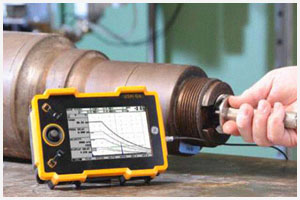
Ultrasonic control, which started with a German patent in 1931 for the first time, started to be used in the industry in the 40s. The development of electronics made a great contribution to the development of this technique as a practical inspection method. It has now become one of the main methods of non-destructive testing.
The operating principle of this test can be described as a material control method using high frequency sound waves. High-frequency sound waves are sent into the material to be controlled. At this time, sound waves reflect if they encounter an obstacle in their path. At this time, the reflected signals, depending on the angle of impact, produce wave lines on the screen of the ultrasonic control means. With these values, both the coordinates of the obstacle in the material are calculated and the size of the obstacle emerges according to the height of the waves. It is even possible to get an idea of the type of obstacle.
Volumetric errors or surface defects such as cracks can be easily determined by this test, especially in pressurized equipment. This process has different methods. For example, high frequency sound waves are sent from a certain point to the pressurized equipment to be inspected by the transmission and reflection method. These waves are seen as echoes on the screen of the controller. By monitoring these echoes, it is determined whether there is any error in the pressure equipment.
In the resonance method, which is another method, the frequency sound waves sent on the pressure vessels to be examined are not constant. The width increases when the frequency of the sound waves from the ultrasonic examination means is the same as the natural frequency of the pressure vessels. This increase in width is determined by the distance between the wavelengths of the echoes reflected on the screen of the ultrasonic examination device. This method is also used for measuring the thickness of pressure vessels with parallel surfaces.
The most common types of waves used in ultrasonic testing are longitudinal (pressure) and transverse (shear) waves. The waves that travel through the pressure vessels during the test are longitudinal waves, ie pressure waves.
Measurements that can be done in ultrasonic testing and inspection, Size (thickness), Length and thickness, Ultrasonic thermometer (temperature change in size), Surface hardness Determination of properties, Grain size, decomposed phases, residues, cold and hot processing degrees, determination of internal stresses and errors .
Ultrasonic examinations and tests have certain advantages over others. For example, errors of pressure vessels can be detected in three dimensions. It is sensitive to the detection of errors. These tests are easy to implement. Does not require the use of excess consumables. Particularly in thick pressure vessels, planar errors can be detected more precisely.
Advantages of Ultrasonic Control can be listed as follows.
Only one side of the material is sufficient,
Can be used in many kinds of materials,
The most suitable method for finding internal discontinuities,
To be portable,
High penetration ability
Immediate results,
Adaptability to automatic systems
For more information, you can reach our expert team from our contact addresses and phone numbers and you can get answers to all your questions.